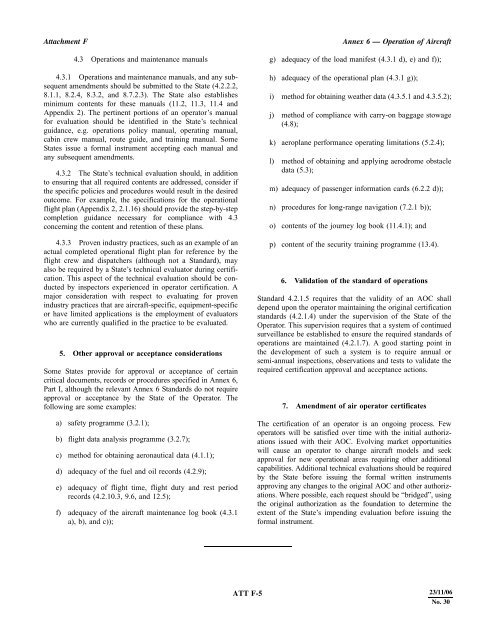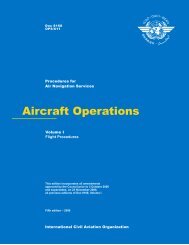Operation of Aircraft
Annex 6, Part I
Annex 6, Part I
- No tags were found...
You also want an ePaper? Increase the reach of your titles
YUMPU automatically turns print PDFs into web optimized ePapers that Google loves.
Attachment F<br />
4.3 <strong>Operation</strong>s and maintenance manuals<br />
4.3.1 <strong>Operation</strong>s and maintenance manuals, and any subsequent<br />
amendments should be submitted to the State (4.2.2.2,<br />
8.1.1, 8.2.4, 8.3.2, and 8.7.2.3). The State also establishes<br />
minimum contents for these manuals (11.2, 11.3, 11.4 and<br />
Appendix 2). The pertinent portions <strong>of</strong> an operator’s manual<br />
for evaluation should be identified in the State’s technical<br />
guidance, e.g. operations policy manual, operating manual,<br />
cabin crew manual, route guide, and training manual. Some<br />
States issue a formal instrument accepting each manual and<br />
any subsequent amendments.<br />
4.3.2 The State’s technical evaluation should, in addition<br />
to ensuring that all required contents are addressed, consider if<br />
the specific policies and procedures would result in the desired<br />
outcome. For example, the specifications for the operational<br />
flight plan (Appendix 2, 2.1.16) should provide the step-by-step<br />
completion guidance necessary for compliance with 4.3<br />
concerning the content and retention <strong>of</strong> these plans.<br />
4.3.3 Proven industry practices, such as an example <strong>of</strong> an<br />
actual completed operational flight plan for reference by the<br />
flight crew and dispatchers (although not a Standard), may<br />
also be required by a State’s technical evaluator during certification.<br />
This aspect <strong>of</strong> the technical evaluation should be conducted<br />
by inspectors experienced in operator certification. A<br />
major consideration with respect to evaluating for proven<br />
industry practices that are aircraft-specific, equipment-specific<br />
or have limited applications is the employment <strong>of</strong> evaluators<br />
who are currently qualified in the practice to be evaluated.<br />
5. Other approval or acceptance considerations<br />
Some States provide for approval or acceptance <strong>of</strong> certain<br />
critical documents, records or procedures specified in Annex 6,<br />
Part I, although the relevant Annex 6 Standards do not require<br />
approval or acceptance by the State <strong>of</strong> the Operator. The<br />
following are some examples:<br />
a) safety programme (3.2.1);<br />
b) flight data analysis programme (3.2.7);<br />
c) method for obtaining aeronautical data (4.1.1);<br />
d) adequacy <strong>of</strong> the fuel and oil records (4.2.9);<br />
e) adequacy <strong>of</strong> flight time, flight duty and rest period<br />
records (4.2.10.3, 9.6, and 12.5);<br />
f) adequacy <strong>of</strong> the aircraft maintenance log book (4.3.1<br />
a), b), and c));<br />
Annex 6 — <strong>Operation</strong> <strong>of</strong> <strong>Aircraft</strong><br />
g) adequacy <strong>of</strong> the load manifest (4.3.1 d), e) and f));<br />
h) adequacy <strong>of</strong> the operational plan (4.3.1 g));<br />
i) method for obtaining weather data (4.3.5.1 and 4.3.5.2);<br />
j) method <strong>of</strong> compliance with carry-on baggage stowage<br />
(4.8);<br />
k) aeroplane performance operating limitations (5.2.4);<br />
l) method <strong>of</strong> obtaining and applying aerodrome obstacle<br />
data (5.3);<br />
m) adequacy <strong>of</strong> passenger information cards (6.2.2 d));<br />
n) procedures for long-range navigation (7.2.1 b));<br />
o) contents <strong>of</strong> the journey log book (11.4.1); and<br />
p) content <strong>of</strong> the security training programme (13.4).<br />
6. Validation <strong>of</strong> the standard <strong>of</strong> operations<br />
Standard 4.2.1.5 requires that the validity <strong>of</strong> an AOC shall<br />
depend upon the operator maintaining the original certification<br />
standards (4.2.1.4) under the supervision <strong>of</strong> the State <strong>of</strong> the<br />
Operator. This supervision requires that a system <strong>of</strong> continued<br />
surveillance be established to ensure the required standards <strong>of</strong><br />
operations are maintained (4.2.1.7). A good starting point in<br />
the development <strong>of</strong> such a system is to require annual or<br />
semi-annual inspections, observations and tests to validate the<br />
required certification approval and acceptance actions.<br />
7. Amendment <strong>of</strong> air operator certificates<br />
The certification <strong>of</strong> an operator is an ongoing process. Few<br />
operators will be satisfied over time with the initial authorizations<br />
issued with their AOC. Evolving market opportunities<br />
will cause an operator to change aircraft models and seek<br />
approval for new operational areas requiring other additional<br />
capabilities. Additional technical evaluations should be required<br />
by the State before issuing the formal written instruments<br />
approving any changes to the original AOC and other authorizations.<br />
Where possible, each request should be “bridged”, using<br />
the original authorization as the foundation to determine the<br />
extent <strong>of</strong> the State’s impending evaluation before issuing the<br />
formal instrument.<br />
ATT F-5 1/11/01 23/11/06<br />
No. 30












